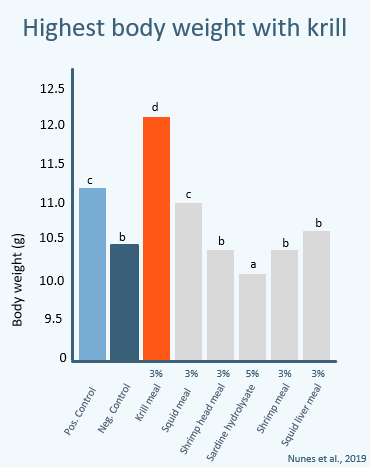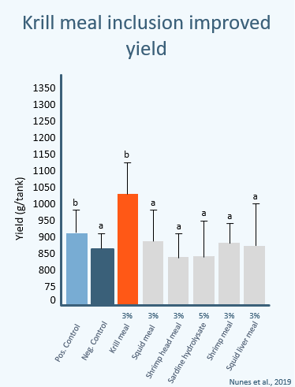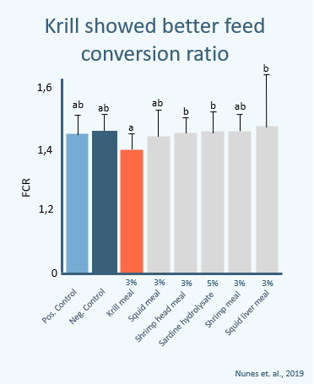Krill is an important source of protein, omega-3 fatty acids and feed attractants which makes it a great ingredient in feeds for shrimp. Research is constantly done to learn how its dietary inclusion can give the best results. Late 2019, a study concluded that krill in fishmeal-challenged diets resulted in:
- Best growth
- Lowest feed conversion ratio
- Best yield
Study analyzed the effects of krill meal and other marine ingredients in low-fish meal diets
The Labomar scientists started out with a baseline diet of 3% fish meal, which was supplemented with either 3% krill meal, squid meal, shrimp head meal, squid liver meal, salmon meal (positive control diet), soy protein concentrate, or liquid sardine hydrolysate (5%). All of these ingredients are considered to be chemoattractants, meaning they induce or attract the shrimp toward it.
The shrimp in the study were fed their respective diets 10 times per day for 74 days. Following the feed trial, they were counted, weighed and their growth performance and feed efficiency were analyzed. The scientists also evaluated feed preference among the shrimp, by offering the shrimp two diets simultaneously in two separate feeding trays, evaluating which feed was the preferred choice.
Highest body weight among shrimp fed the krill meal supplemented diet
Once weighed, the shrimp fed the krill meal diet had the highest body weight, followed by the positive control diet of salmon meal, and then the squid meal diet. The shrimp fed the sardine hydrolysate diet had the lowest body weight at the end of the trial.

Overall survival of the shrimp was unaffected by the various diets, though the highest gained yield resulted from diets containing krill meal and salmon meal. The scientists also reported that the lowest feed conversion ratio (FCR) was among the shrimp fed the krill meal supplemented diet, showing the efficiency of krill meal in the shrimp diet.


Also read our blog post: 7 reasons to include krill in your shrimp feed
Feed attractability doesn’t necessarily ensure shrimp growth
In this study, the scientists found that the shrimp preferred the shrimp head meal diet over the krill meal diet, in a side-by-side comparison. However, this preference did not lead to greater growth among the shrimp fed the shrimp head supplemented diet. One of the possible reasons for this result is the presence of cadaverine, putrescine and tyramine in the shrimp head and shrimp liver meal. These biogenic amines may have compromised the nutrient quality of the feed, which affected the overall growth.
When fish meal in shrimp diets is low, krill meal is a powerful addition
The final results of this study had one very clear result: krill meal was the most effective in increasing body weight, final yield and in reducing FCR. These attributes of a krill meal diet can prove quite beneficial to a shrimp farm, as increased growth can improve production efficiency. The shrimp grow bigger, faster and more of them survive, resulting in an earlier harvest and greater crop turnover for farmers.
The quick turnover also reduces the risk for disease occurrence among the shrimp. The Labomar scientists concluded that krill meal showed a unique balance of higher feed attractiveness and stimulation, coupled with a steady supply of dietary nutrients, which no other ingredient in this study was able to match.
Learn more about the highly attractive feeding stimulant for shrimp feed, by downloading our whitepaper below.
